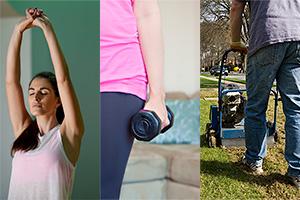Quick Tips: Getting Active at Home
Get started
It’s best to increase your activity in all three areas of fitness: flexibility, aerobic fitness, and muscle fitness. You can work on all three areas without leaving home.
If you have heart problems or other health issues, or if you have not been active for a long time, check with your doctor before you start a new activity.

Flexibility and stretching
Flexibility is the ability to move your joints and muscles through their full range of motion. Stretching is an activity that helps you to be more flexible. It’s also something you can easily do at home.
Stretching at home
- Warm up your muscles slightly before you stretch them. Walk or do some other light aerobic exercise for a few minutes, and then start stretching.
- Ease yourself into the stretch, relax, and don’t push or bounce. You should feel a stretch, but not pain, in the muscle.
- Exhale as you do the stretch. While you hold the stretch, inhale deeply.
- Try closing your eyes while you stretch. It helps you relax.
- Take a moment to enjoy the good, warm feeling that comes after a good stretch.
Exercise DVDs can teach you more about stretching various muscles.
Aerobic fitness (endurance)
Aerobic fitness means increasing how well your body uses oxygen. Look for activities that make your heart beat faster and make you breathe harder.
Experts suggest that you do at least 2½ hours of moderate activity a week or at least 1¼ hours of vigorous activity a week. It’s fine to do blocks of 10 minutes or more throughout your day and week.
|
Moderate |
Vigorous |
|---|---|
|
|
Muscle fitness (strength)
Muscle fitness means building stronger muscles and increasing how long you can use them. You can strengthen a muscle by doing any activity that pushes or pulls against that muscle.
Experts say that you should work on strengthening your muscles at least 2 times a week. Focus on the large muscle groups in your arms, legs, back, chest, and core.
Strengthening your muscles at home
- Do familiar exercises, like push-ups and leg lifts.
- Use rubber tubing or stretchable bands to add resistance as your muscles work against the elastic.
- Use free weights (“dumbbells”) or a weight-training machine. If you don’t have free weights, you can lift soup cans, water bottles, or books.
- Do housework and yard work, such as scrubbing the bathtub, washing walls, tilling the garden, or pulling weeds, on a regular basis.
- Strengthen your core. Pull in your belly. Imagine pulling your belly button back toward your spine. Hold this for 5 to 10 seconds, then relax. Breathe normally as you hold the muscle tight. Repeat. You can do this exercise anywhere, in any position.
Health Tools
Health Tools help you make wise health decisions or take action to improve your health.
Current as of: May 5, 2019
Author: Healthwise Staff
Medical Review:E. Gregory Thompson, MD – Internal Medicine & Martin J. Gabica, MD – Family Medicine & Adam Husney, MD – Family Medicine & Kathleen Romito, MD – Family Medicine & Elizabeth T. Russo, MD – Internal Medicine
Topic Contents
This information does not replace the advice of a doctor. Healthwise, Incorporated, disclaims any warranty or liability for your use of this information. Your use of this information means that you agree to the Terms of Use. Learn how we develop our content.

